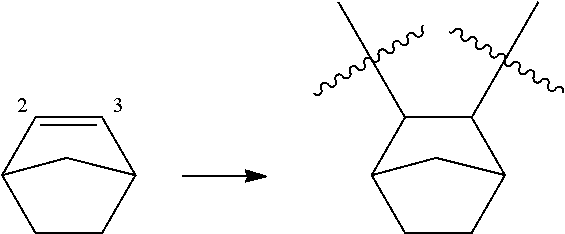Polycycloolefin polymer compositions as optical materials
a polycycloolefin and composition technology, applied in the field of mass polymerizable polycycloolefin monomer compositions, to achieve the effects of low viscosity, good uniform leveling, and high colorless optical transparency
- Summary
- Abstract
- Description
- Claims
- Application Information
AI Technical Summary
Benefits of technology
Problems solved by technology
Method used
Image
Examples
example 1
[0212]
[0213]Synthesis of PhPhMaBr.
[0214]Magnesium (35.5 g, 1.46 mol) was placed inside a suitable reaction vessel equipped with a large stirbar, thermowell, condenser with valved gas inlet adapter and two appropriately sized addition funnels capped with septa. The vessel was heated to 193° C. while under a nitrogen purge. The magnesium was stirred. The vessel was cooled to 14° C. Five hundred mL anhydrous THF was transferred via cannula and vacuum into one addition funnel. 4-Bromobiphenyl (BrPhPh, 336.24 g, 1.44 mol) was dissolved under nitrogen in a septa-capped 1 L flask with 500 mL anhydrous THF. The mixture was sonicated and gave ˜750 mL solution. This was transferred by cannula and vacuum into the other addition funnel. The BrPhPh / THF solution was added dropwise to the Mg. After 7 minutes, the temperature rose from 14° C. to 27° C., but the mixture was starting to reflux. The liquid level had not reached the tip of the thermowell. Five hundred mL of THF was added quickly. The t...
example 2
[0218]
[0219]A 500 mL reactor equipped with a septum and a magnetic stirbar was charged with a solution of 9-fluorenylmethoxycarbonyl chloride (50 g, 193.8 mmol, 1 eq) in THF (250 mL). The reactor was sealed and vented with three 16 G needles and placed in a water bath at room temperature. To this stirred solution was added 5-norbornene-2-methanol (24.6 g, 198.6 mmol, 1.03 eq) along with pyridine (15.7 g, 198.6 mmol, 1.03 eq) simultaneously over 20 minutes. After addition the reaction mixture was allowed to stir at room temperature for 4 days.
[0220]The reaction mixture became a slurry with white solid and a light yellow reaction liquid. The reaction mixture was filtered through a coarse glass frit and the solids were washed with THF (100 mL). The organics were removed by rotary evaporation to dryness resulting in a light yellow solid.
[0221]The crude solid was dissolved in a solvent mixture of EtOAc (150 mL) and THF (25 mL), and mixed until it became a solution. Silica gel (40 g) was ...
example 2a
[0223]
[0224]Into a 500 mL reactor purged with dry nitrogen and equipped with septum, dropping funnel, thermocouple and a magnetic stirbar was charged with a solution of 5-(ethoxydimethylsilyl)bicyclo[2.2.1]hept-2-ene (27.1 g, 138.4 mmol) in 100 mL of toluene. The reactor was sealed and vented with three 16 G needles and placed in a water bath at room temperature. To this stirred solution was added a solution of triphenylsilane (30 g, 115.3 mmol) and tris(pentafluorophenyl)borane (2.9 g, 5.7 mmol) in 100 mL of toluene using a dropping funnel while maintaining the reaction temperature at room temperature. The reaction mixture was then allowed to stir at room temperature for an additional period of 5 hrs. After which time the reaction mixture was poured onto 15 g of neutral alumina and stirred at room temperature for 10 min to allow alumina to be dispersed into the reaction mixture and then filtered using silica (top) / celite (bottom) plug. The filtrate was rotary evaporated to remove s...
PUM
| Property | Measurement | Unit |
|---|---|---|
| viscosity | aaaaa | aaaaa |
| refractive index | aaaaa | aaaaa |
| transparent | aaaaa | aaaaa |
Abstract
Description
Claims
Application Information
 Login to View More
Login to View More - R&D
- Intellectual Property
- Life Sciences
- Materials
- Tech Scout
- Unparalleled Data Quality
- Higher Quality Content
- 60% Fewer Hallucinations
Browse by: Latest US Patents, China's latest patents, Technical Efficacy Thesaurus, Application Domain, Technology Topic, Popular Technical Reports.
© 2025 PatSnap. All rights reserved.Legal|Privacy policy|Modern Slavery Act Transparency Statement|Sitemap|About US| Contact US: help@patsnap.com



